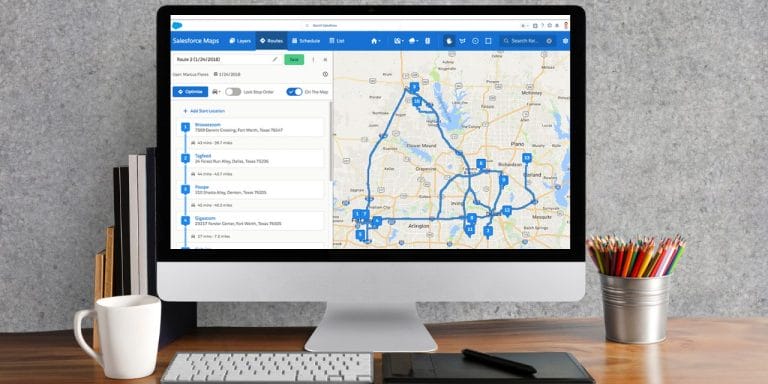Most sales leaders design territories the same way they did five years ago—and wonder why quota attainment keeps dropping. The math is brutal: field reps spend 35–39% of their time actually selling, while the rest gets eaten by bad routes, unclear ownership, and chasing low-fit accounts. Meanwhile, companies with optimized territory plans see 10–20% higher productivity and 20% more revenue—without adding headcount.
The difference? A sales territory plan built on data, not legacy assignments. In 2026, the winners are teams that match the right reps to the right accounts, balance workloads using real metrics, and treat territories as a living asset—not a static map drawn once and forgotten.
This guide walks you through the exact framework to design, launch, and manage territories that drive predictable growth.
What Is a Sales Territory Plan?
A sales territory plan divides your market into manageable segments and assigns those segments to specific reps. The goal: every customer gets the attention they deserve, and every rep has a fair, achievable workload that maximizes their selling time.
Territories can be structured by:
- Geography: States, zip codes, cities, or drive-time zones
- Industry: Healthcare, manufacturing, retail, construction
- Account size: Enterprise, mid-market, SMB
- Customer type: New business, expansion accounts, renewals
- Revenue potential: High-value targets, growth accounts, protect-and-grow segments
The right approach depends on your business model, team strengths, and where your best opportunities sit. In 2026, the most effective territory plans blend multiple criteria—pairing geography with account potential or industry specialization—to create balanced, high-performing coverage.
Why Sales Territory Planning Matters in 2026
An effective territory plan is the foundation for predictable revenue growth. Territory design can increase revenue by 2–7% without changes to overall strategy or resources. Here’s the business case:
Higher Rep Productivity: Field sales reps spend only 35–39% of their time actively selling. Strategic territory design cuts non-selling tasks—redundant travel, low-fit prospecting, account confusion—and pushes that number toward 60–70%. Clear ownership means reps spend less time sorting leads and more time closing deals.
Better Customer Experience: Customers want consistent, knowledgeable attention. Defined territories ensure prospects get follow-up from reps who understand their business, industry challenges, and buying cycle—not scattered outreach from multiple reps or radio silence.
Balanced Workloads Prevent Burnout: Poor territory design overloads top performers while leaving others underutilized. Data-driven workload balancing—using account count, revenue potential, and travel time—keeps territories fair and reps engaged.
Revenue Growth Without Adding Headcount: Samsung cut operational costs by $8.8 million (25% reduction) and increased customer visits by 50% simply by optimizing territory coverage. Companies with optimized territory plans see 10–20% greater sales productivity and 20% more revenue. Smart territory design unlocks existing capacity before you hire.
Clear Accountability Drives Performance: When every rep owns specific accounts and metrics, coaching gets easier and forecast accuracy improves. Managers can pull conversion reports by territory, spot gaps fast, and adjust coverage before quota suffers.
Real Results: Territory Optimization in Action
After implementing data-driven territory planning with SPOTIO, Lobel Financial transformed their fragmented dealer coverage across 50+ field reps. By using analytics to identify optimal dealer clusters and redesign territories geographically, they quadrupled sales volume in just 8 months. The shift from trust-based territory management to GPS-enabled visit verification and performance dashboards gave leadership the visibility needed to coach reps, set territory-based goals, and drive accountability. Territory optimization turned 45 years of traditional operations into a data-driven growth engine.
7-Step Sales Territory Plan Framework
1. Align Territories to Business Goals
Start with clarity on what you’re trying to achieve. Pull your leadership team together and answer:
- What are our numeric revenue targets for 2026?
- Which products or verticals drive the most growth?
- Are we protecting existing accounts, penetrating new markets, or both?
- What’s our headcount plan—growing, flat, or reallocating?
Translate these into territory-level criteria. If you’re launching a new product line, carve out dedicated territories for reps with technical selling experience. If you’re defending market share in competitive regions, assign your strongest closers there. Territory design should mirror your strategic bets, not just replicate last year’s map.
Example: A solar company targeting 30% growth in residential installs might split territories into “high-adoption metro zones” (existing demand) and “education-heavy rural zones” (emerging markets requiring longer sales cycles and relationship building).
2. Segment Customers and Prospects
Use your CRM to identify patterns among your best customers:
- What industries or verticals convert fastest?
- What account sizes deliver the highest lifetime value?
- Which customer types (new business vs. upsell) have the shortest sales cycles?
- What geographic pockets show concentrated demand?
Group similar accounts together. Segmentation lets you tailor coverage strategies—assigning reps who excel at consultative selling to complex enterprise accounts, and fast-moving hunters to high-volume SMB territories. In 2026, AI-driven segmentation tools can surface non-obvious patterns—for instance, homeowners with high energy costs who engage financing content might convert 3x faster—giving you an edge competitors miss.
3. Size Your Total Addressable Market
Calculate the total number of potential customers who fit your ideal profile. Use:
- CRM data: Current customers and pipeline
- Third-party databases: D&B, ZoomInfo, LinkedIn Sales Navigator
- Public sources: Industry associations, Census data, local business registries
- Field sales tools: SPOTIO’s Google Places integration for B2B or Lead Machine for residential (15 data points per prospect)
Rank accounts by revenue potential and strategic fit. Build a simple scoring model—1 to 5 scale based on factors like deal size, buying signals, competitive presence, and fit with your ICP. This prevents the common mistake of treating all accounts equally when 20% of your TAM likely represents 80% of winnable revenue.
4. Run a Territory-Level SWOT
SWOT analysis helps you decide where to focus resources and where you need to shore up weaknesses:
- Strengths: What advantages do you have in specific markets? (Brand recognition, customer concentration, rep expertise)
- Weaknesses: Where are you vulnerable? (Thin coverage, high churn, weak competitive positioning)
- Opportunities: What emerging trends or markets can you capture? (New industries, product launches, competitor exits)
- Threats: What external risks exist? (Economic shifts, new competitors, regulatory changes)
Use SWOT outcomes to inform territory assignments. A high-opportunity vertical with fierce competition may need a dedicated specialist. A strength that’s also a large opportunity—like an industry where you dominate—may justify splitting one territory into two to capture more share.
5. Design and Document Sales Territories
Draw clear boundaries for each territory. Consider:
- Geography: Zip codes, cities, drive-time zones (avoid arbitrarily large regions that waste travel hours)
- Industry verticals: Healthcare, construction, retail (especially effective for complex B2B sales)
- Account size tiers: Enterprise (>$10M revenue), mid-market ($1M–$10M), SMB (<$1M)
- Product focus: Reps specializing in specific solutions or service lines
- Customer lifecycle: New business hunters vs. account managers handling renewals and upsells
Assign reps based on skills, relationships, and workload capacity. Match experienced closers to high-complexity or high-value territories. Give newer reps development territories with shorter sales cycles and coaching support.
Document everything in your CRM or territory management tool. Define rules of ownership: What happens when accounts move? Who owns inbound leads in a territory? How do you handle national accounts with local presence? Fuzzy boundaries create conflict and dropped deals—spell out the logic.
Use territory mapping software to visualize coverage, identify gaps, and balance workloads. In 2026, AI-powered mapping tools auto-generate balanced territories based on criteria you set—cutting manual planning time dramatically.
6. Build Territory-Level Action Plans
For every territory, define clear execution plans:
Set targets: Quotas, pipeline coverage (3–4x quota), and activity minimums (meetings per week, new accounts prospected). Tie targets to comp plans so reps know exactly what winning looks like.
Prioritize accounts: Build a top-25 target list per territory. Score accounts by conversion probability and assign visit cadences—A-accounts every 2 weeks, B-accounts monthly, C-accounts quarterly.
Route inbound leads intelligently: Send high-intent inbound leads to reps who excel at fast follow-up. Assign outbound-heavy territories to strong prospectors. Match lead source and type to rep strengths.
Optimize routes and schedules: Use route planning tools to group appointments by geography and minimize drive time. Plan outreach 60–90 days before peak buying seasons in your industry—don’t wait until prospects are already in-market.
Example: A pest control company might plan spring renewal campaigns in January (60 days early), route reps through neighborhoods clustered by service history, and set activity targets of 15 door knocks plus 5 scheduled follow-ups per day.
7. Track Territory Performance and Adjust
Monitor progress with real-time dashboards, not monthly spreadsheets. Track:
- Revenue and gross profit per territory
- Quota attainment rates by rep and segment
- Pipeline coverage (value of open opps ÷ quota)
- Conversion rates at each stage (lead → meeting → proposal → close)
- Activity metrics (appointments set, site visits, proposals delivered)
- Customer retention and repeat business in each territory
Hold quarterly territory reviews to assess performance and rebalance coverage. Ask:
- Are any territories consistently over or under quota? (Signal for reassignment or split/merge)
- Where are conversion rates dropping? (Coaching opportunity or account fit issue)
- What new opportunities are reps seeing on the ground? (Emerging verticals, competitor weaknesses)
- Are workloads still balanced, or has growth skewed territory size?
In fast-changing markets, review monthly. Adjust territories, goals, or resources based on performance data—not gut feel. Companies that dynamically adjust territories see up to 30% more revenue per rep than those using static models. Treat your territory plan as a living asset, not a set-it-and-forget-it map.
Sales Territory Management Best Practices
Balance Workloads Using Multiple Factors
Account count alone doesn’t tell the full story. Balance territories by:
- Revenue potential: Total ARR or deal value available in the territory
- Account complexity: Enterprise deals require more touches than SMB
- Drive time: A territory with 100 accounts spread across 3 states isn’t equal to 100 accounts in one metro
- Deal cycle length: Longer cycles mean fewer closed deals per quarter—adjust quotas accordingly
Use the +/- 10% workload rule: No territory should have more than 10% higher or lower total workload (measured by potential revenue and effort required) than the team average. This keeps territories fair and prevents burnout.
Use Data, Not Legacy Assignments
The biggest territory planning mistake? Designing around “who’s always owned that account” instead of where your best opportunities are. Pull CRM data to see:
- Which segments have the highest win rates
- Where reps are spending time vs. where revenue is coming from
- Which territories are underperforming relative to market potential
Reassign accounts when data shows a better fit. If a rep is underwater in a high-potential territory, that’s a $500K+ opportunity cost—fix it fast.
Partner With Reps on Territory Design
Field reps surface insights managers can’t see from dashboards. They know:
- Which accounts are about to churn
- Where competitors just lost a deal
- What pockets of demand are emerging in their region
Run quarterly feedback sessions and ride-alongs to validate your territory logic. When reps have input, they buy in—and they sell harder in territories they helped design.
Leverage Technology for Continuous Optimization
Spreadsheets can’t scale territory management in 2026. Use territory mapping and management platforms that:
- Visualize coverage gaps and rep overlap on a map
- Auto-balance territories when you add or remove reps
- Calculate optimal routes and estimate drive time
- Provide real-time performance dashboards by territory, rep, and segment
AI-driven tools can predict which territories will underperform based on activity trends and recommend coverage adjustments before quota is at risk.
For a deeper breakdown of mapping and territory management platforms, including pros, cons, and pricing, check out this guide to the 10 best sales mapping software tools for 2025.
Measuring a Sales Territory Plan
Core Territory KPIs
Track these metrics to validate your territory plan is working:
| KPI | What It Measures | Why It Matters |
|---|---|---|
| Revenue per territory | Total closed revenue in the period | Are territories producing expected returns? |
| Quota attainment | % of reps hitting quota | Is workload balanced and quota realistic? |
| Pipeline coverage ratio | Pipeline value ÷ quota | Do reps have enough open opps to hit target? (3–4x is healthy) |
| Win rate | Closed-won ÷ total opportunities | Are reps pursuing the right accounts? |
| Average deal size | Total revenue ÷ number of deals | Are reps focused on high-value opportunities? |
| Sales cycle length | Days from lead to close | Are territories structured for efficient conversion? |
| Customer retention rate | % of accounts renewing or buying again | Is territory coverage maintaining relationships? |
Compare performance within territories over time and across territories to spot patterns. If one territory consistently outperforms, what’s different? Rep skill, account quality, or market conditions?
Territory Review Cadence
Review territories quarterly at minimum. In high-growth or volatile markets, shift to monthly check-ins with quarterly deep dives. Use reviews to:
- Rebalance workloads when reps are over/under capacity
- Reassign accounts that aren’t getting adequate attention
- Split high-performing territories to capture more growth
- Merge underperforming territories to consolidate coverage
Don’t wait until year-end to fix broken territories. By then, you’ve lost two quarters of revenue.
Common Territory Planning Mistakes
Unclear Ownership and Overlaps
Fuzzy boundaries create conflict. Two reps contact the same lead. An account with locations in multiple territories gets ignored because no one owns it. Deals fall through the cracks.
Fix it: Document territory rules in your CRM. Define who owns multi-location accounts, how inbound leads are routed, and what happens when accounts relocate or expand. Make ownership visible to the entire team.
Static Territories in a Moving Market
“Set and forget” territories fail when customer behavior, competition, and market demand keep shifting. Sticking with 2023’s territory map in 2026 means missed opportunities and frustrated reps.
Fix it: Treat territories as a living asset. Review quarterly, adjust based on performance data, and stay alert to field feedback about emerging demand or competitive moves.
Ignoring Rep Strengths
Assigning a new hire to a complex enterprise territory or putting a relationship-builder in a high-volume transactional role tanks performance. Misaligned assignments hurt quota attainment and rep morale.
Fix it: Match reps to territories based on skills and experience. Give top closers your highest-potential accounts. Assign development territories (shorter cycles, coaching support) to newer reps. Audit territory-rep fit every quarter.
Over-Relying on Geography Alone
Geographic territories make sense for logistics—but they ignore account potential, industry expertise, and buying behavior. A rep covering “the entire Southeast” may miss high-value verticals buried in the vastness.
Fix it: Layer criteria—combine geography with industry, account size, or revenue potential. Hybrid models (e.g., “Healthcare accounts in metro Atlanta”) deliver better results in 2026 than pure geography.
Lack of Data Behind Decisions
Designing territories based on gut feel or legacy assignments leaves money on the table. You can’t optimize what you don’t measure.
Fix it: Use CRM analytics, win-rate data, and territory-level KPIs to drive every design decision. If you can’t explain why a territory is structured the way it is using data, redesign it.
FAQs About Sales Territory Plans
How often should I review and adjust my territory plan?
Quarterly at minimum, monthly in fast-changing markets. Use real-time dashboards to spot issues between formal reviews—don’t wait 90 days if a territory is clearly off track.
What’s the best way to balance territory workloads?
Use a mix of account count, revenue potential, deal complexity, and drive time. Apply the +/- 10% rule: no territory should have more than 10% higher or lower total workload than the team average. Get rep feedback to validate your math.
Should I design territories by geography or industry?
It depends on your sales motion. Door-to-door and route-based sales favor geography to minimize drive time. Complex B2B sales often benefit from industry specialization, where deep vertical expertise drives higher win rates. Hybrid models (geography + vertical) work best for many mid-market field teams.
How do I handle new hires or rep turnover?
Keep territory assignments documented and up to date in your CRM. Assign new reps to less complex, shorter-cycle territories at first. When a top performer leaves, reassign their high-value accounts to your strongest available rep immediately—don’t let them go cold.
Should I use software or manage territories manually?
Manual territory management (spreadsheets, static maps) breaks down fast as you scale. Invest in CRM-integrated territory mapping and management software from day one. Platforms cut planning time dramatically and surface insights spreadsheets can’t deliver.
How do I measure if my territory plan is working?
Track revenue per territory, quota attainment, pipeline coverage (3–4x quota), win rates, and customer retention. Compare performance across territories and over time. If multiple territories consistently miss quota, your workload balance or market segmentation is off.
What’s the ROI of territory planning software?
Companies using territory mapping and optimization tools report 25% cost reductions and 50% increases in customer visits. Data-driven sales processes deliver 5–6% higher productivity. ROI shows up in reduced windshield time, higher quota attainment, and faster onboarding for new reps.
Strategic territory planning separates high-performing field teams from those stuck in reactive mode. In 2026, the advantage goes to teams that design territories using data, adjust coverage in real time, and match the right reps to the right opportunities.
SPOTIO helps field sales teams plan smarter territories, optimize routes, and track performance in one platform. Teams using SPOTIO log activities with one tap, visualize coverage gaps on a map, and sync territory data seamlessly to their CRM—cutting admin time and boosting selling hours. Want to see how SPOTIO can transform your territory strategy? Click here for a demo.




